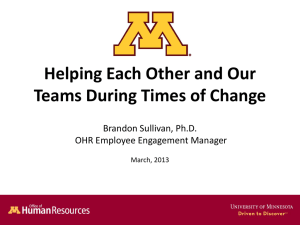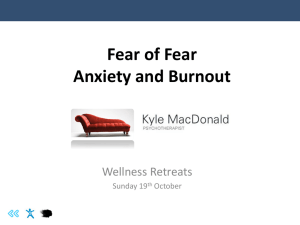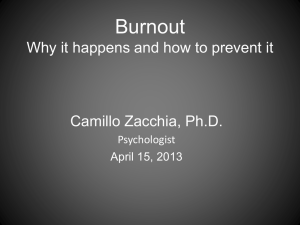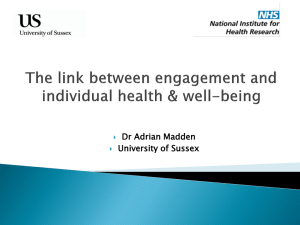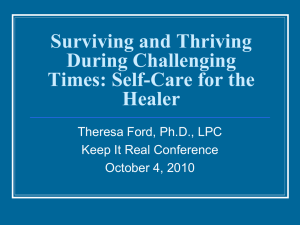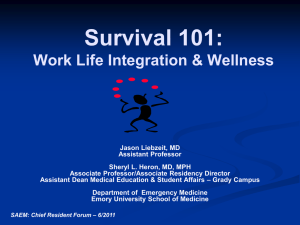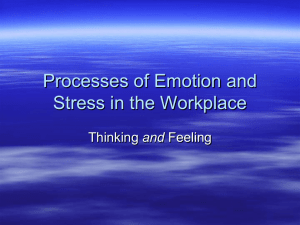Hopkins-Gardner - The New Zealand Psychological Society
advertisement
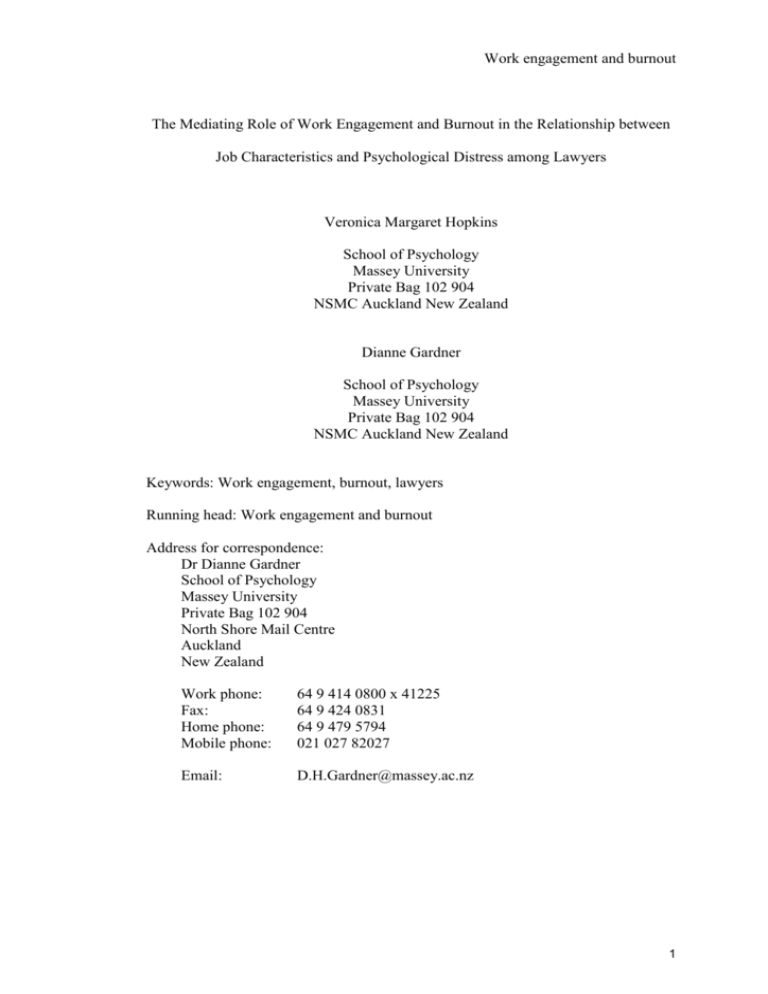
Work engagement and burnout The Mediating Role of Work Engagement and Burnout in the Relationship between Job Characteristics and Psychological Distress among Lawyers Veronica Margaret Hopkins School of Psychology Massey University Private Bag 102 904 NSMC Auckland New Zealand Dianne Gardner School of Psychology Massey University Private Bag 102 904 NSMC Auckland New Zealand Keywords: Work engagement, burnout, lawyers Running head: Work engagement and burnout Address for correspondence: Dr Dianne Gardner School of Psychology Massey University Private Bag 102 904 North Shore Mail Centre Auckland New Zealand Work phone: Fax: Home phone: Mobile phone: 64 9 414 0800 x 41225 64 9 424 0831 64 9 479 5794 021 027 82027 Email: D.H.Gardner@massey.ac.nz 1 Work engagement and burnout Abstract Research to date indicates that lawyers are disproportionately affected by psychological distress when compared to the general population, and other occupations. In this study, the Job Demands-Resources Model was used to identify job characteristics associated with psychological distress among lawyers, and to explore the mediating roles of burnout and work engagement. Legal staff (N = 94) from a large New Zealand firm completed a survey on job characteristics, burnout (work-related fatigue), engagement and psychological distress. Regression analyses provide support for the strain and motivational pathways of the Job DemandsResources Model. Results suggest a dual focus on reducing job demands related to burnout, and increasing the availability of job resources to enhance work engagement, may help combat psychological distress among lawyers. Key words: Burnout, Engagement, Psychological Distress, Job Demands-Resources Model 2 Work engagement and burnout Research carried out with lawyers to date indicates that they are more likely to be affected by psychological distress (e.g. symptoms of depression and anxiety) compared to the general population and to other occupations. Studies undertaken in the United States have consistently shown that lawyers are more than twice as likely as the general population to experience depression (Benjamin, Darling & Sales, 1990; Daicoff, 2004). In addition, lawyers report elevated levels of anxiety when compared to the general population (Beck, Sales & Benjamin, 1995; Daicoff, 2004). This trend does not appear limited to the United States, with recent research indicating that Australian lawyers also suffer from higher than average rates of psychological distress than the general population (Nelk, Loscombe, Medlow & Hickie, 2009). Three avenues of research have emerged to explore why lawyers suffer from high levels of depression and anxiety. Studies have been undertaken with law students to understand whether the experience of law school impacts on mental health (e.g. Benjamin, Kaszniak, Sales, & Shanfield, 1986; Sheldon & Krieger, 2004). Other research has focused on common personality traits argued to be prevalent among lawyers such as pessimism, perfectionism and need for achievement and whether these make lawyers more susceptible to psychological distress (e.g Daicoff, 2004; Elwork, 2007; Peterson & Seligman, 1984; Satterfield, Monahan, & Seligman, 1997; Seligman, Verkuil, & Kang, 2005). A third avenue of research has focused on environmental factors such as lawyers’ working conditions. This is the focus of the present study. There is evidence to suggest that job characteristics such as work-family conflict, lack of job control, lack of social support and lack of feedback may impact on job dissatisfaction, a correlate of psychological distress (Daicoff, 2004). For 3 Work engagement and burnout instance, in a study of Chicago lawyers Heinz, Hull, & Harter (1999) found that lawyers who perceived less conflicting career and personal demands and those who could balance these demands were more likely to be satisfied with their job. In addition, Heinz et al. (1999) found that job autonomy was positively related to job satisfaction, with those lawyers who indicated greater freedom in selecting clients and more autonomy over their work being more likely to report high job satisfaction. Research has shown that lawyers who perceived a lack of social support available to them, or reported that their colleagues were unsupportive, were more likely to be dissatisfied with their job (McCann, Russo, & Benjamin, 1997). In addition, the availability and quality of mentoring (including career advice and psychosocial support) from supervisors and colleagues were positively associated with job satisfaction among lawyers (Higgins & Thomas, 2001). Other aspects of work that may contribute to lawyer dissatisfaction include time pressures, work overload, increasing pressures from employers for more billable hours, lack of respect from superiors and client demands (Daicoff, 2004). In addition, the law firm culture may contribute to a sense of generalised anxiety, with internal politics and the adversarial system of law promoting an environment of hostility, suspicion and cynicism (Elwork & Benjamin, 1995). This study aims to provide insight into how aspects of lawyers’ work can lead to negative psychological outcomes such as burnout and psychological distress as well as positive outcomes such as work engagement. High levels of burnout are associated with increased psychological distress (Shirom, Melamed, Toker, Berliner, & Shapira, 2005), and high levels of work engagement are associated with reduced psychological distress (Hallberg & Schaufeli, 2006). Investigating job characteristics 4 Work engagement and burnout associated with burnout and work engagement can provide insight into those aspects of work which can influence mental health outcomes. Job Demands and Resources The Job Demands-Resources (JD-R) Model (Schaufeli & Bakker, 2004) proposes that each occupation has specific factors associated with job stress and these factors can be classified into two categories: job demands and job resources (Bakker & Demerouti, 2007). Job demands are those aspects of the job (physical, psychological, social, or organisational) which may become stressors when they require a high degree of effort (Bakker & Demerouti, 2007, Schaufeli & Bakker, 2004). Job resources are the physical, psychological, social, or organisational aspects of work that assist employees in achieving work goals, reducing job demands, increasing motivation and stimulating personal development (Bakker & Demerouti, 2007; Hakanen, Bakker & Schaufeli, 2006). Job resources are not only important in their own right in order to achieve tasks and contribute to personal growth, but can also reduce job demands (Bakker & Demerouti, 2007). The primary outcomes of interest to the JD-R model are burnout and engagement. Burnout is a multi-dimensional concept comprising three components: emotional exhaustion (depletion of emotional energy due to on-going pressures), cynicism (detachment from colleagues and clients, and increased indifference about work), and reduced personal accomplishment (feelings of incompetence) (Maslach, Schaufeli, & Leiter, 2001). Meta-analytic studies have shown that each component has its own unique antecedents and consequences (Schaufeli & Enzmann, 1998). There has been a particular focus on the exhaustion component of burnout. Burnout has been associated with depression (Schaufeli & Enzmann, 1998), poor self-rated health (Melamed, Shirom, Toker, Berliner, & Shapira, 2006), poor quality of sleep 5 Work engagement and burnout (Grossi, Perski, Evengard, Blomkvist, & Orth-Gomer, 2003) and more serious health concerns such as increased risk of musculoskeletal pain (Armon, Melamed, Shirom, & Shapira, 2010), cardiovascular disease and type 2 diabetes (Melamed et al., 2006) and higher risk of mortality among younger workers (Ahola, Vaananen, Koskinen, Kouvonen, & Shirom, 2010). Burnout is also associated with increased employee sick leave and turnover intentions, lower organisational commitment (Lee & Ashforth, 1996), increased turnover (Jackson, Schwab, & Schuler, 1986) and low levels of in-role performance, organisational citizenship behaviour and customer satisfaction (Taris, 2006). Job characteristics tend to be more strongly associated with burnout than demographic or personality factors (Lee & Ashforth, 1996; Schaufeli & Enzmann, 1998). Demanding aspects of work such as having a high workload, experiencing role conflict, a lack of role clarity and high work-family conflict (Netemeyer, Boles, & McMurrian, 1996; Allen, Herst, Bruck, & Sutton, 2000) are associated with high levels of burnout. In addition to studying the impact of job demands on burnout, researchers have also investigated job characteristics which can reduce demands or act as resources. Job resources such as control over work (task autonomy), social support and performance feedback have been associated with reduced burnout (Lee & Ashforth, 1996; Maslach et al., 2001). Work engagement is a relatively new concept (Seligman & Csikszentmihalyi, 2000). Schaufeli, Salanova, Gonzalez-Roma and Bakker (2002) define work engagement as “a positive, fulfilling, work-related state of mind” (p.295) that consists of three dimensions: vigour, dedication, and absorption. Vigour is defined as high levels of energy, a resilient mental attitude and the willingness to invest time and effort into work. Dedication refers to enthusiasm, challenge, and significance, 6 Work engagement and burnout whereas absorption refers to a tendency to be fully engrossed in work and having difficulty detaching from work (Schaufeli et al., 2002). Vigour and dedication are considered to be the core elements of work engagement and are in direct contrast with the exhaustion and cynicism elements of burnout, whereas absorption is not considered to be the opposite of reduced professional efficacy (Schaufeli & Bakker, 2004). As such, this model proposes that work engagement and burnout are negatively, but not perfectly, correlated (Schaufeli et al., 2002). Schaufeli et al.’s (2002) model of work engagement is supported by evidence to suggest that work engagement and burnout have unique defining characteristics and are not empirical opposites (Crawford, LePine, & Rich, 2010; Schaufeli & Bakker, 2004). Accumulated evidence suggests that work engagement is related to a variety of positive outcomes for organisations such as low turnover intention (Schaufeli & Bakker, 2004), high job satisfaction and organisational commitment (Saks, 2006), more discretionary effort (Bakker, Demerouti, & Verbeke, 2004), and higher business performance (Harter, Schmidt, & Hayes, 2002). Although less research has been undertaken on the individual consequences of engagement, studies indicate a negative relationship between work engagement and somatic complaints, sleep disturbances, depression and distress (Hallberg & Schaufeli, 2006; Schaufeli, Taris, & Van Rhenen., 2008). Positive aspects of work (or job resources) that are associated with work engagement include feedback, social support, and supervisory coaching (Schaufeli and Bakker, 2004, Schaufeli, Bakker and Van Rhenen, 2009). In addition, control over important work-related decisions and work that is positively challenging and meaningful and provides a positive sense of identity through a good match between personal and work values are also positively related to work engagement (Saks, 2006; Schaufeli & Bakker, 2004). 7 Work engagement and burnout Job Demands and Resources in the Study The link between stressful work characteristics, the development of burnout and its association with depression presents one pathway to explain the high levels of psychological distress apparent among lawyers. This study investigates the impact of various job characteristics (i.e. job demands) on burnout (in particular, work-related exhaustion) among lawyers. Among lawyers, the job demand most likely to lead to burnout is excessive workload (role overload), which has been consistently associated with emotional exhaustion (Lee & Ashforth, 1996). The legal profession is well known for the pressure to bill more hours to meet targets, which suggests that role overload is likely to be a common occurrence (Daicoff, 2004). A related job demand is work-family conflict. As a consequence of having a high workload, lawyers typically work long hours. This is likely to reduce the time and energy available to invest in their personal life and may lead to conflict between work and home demands, especially among those who have perfectionist tendencies and a high achievement orientation (Elwork, 2007). Work-family conflict is related to job dissatisfaction among lawyers (Heinz et al., 1999) and has been identified as a predictor of burnout (Netemeyer, et al., 1996). Role conflict and lack of role clarity are also related to burnout (Lee & Ashforth, 1996). Lawyers are likely to experience conflicting demands as they typically work for more than one client at a time and for different senior members of the team. In addition, lawyers are required to be very accurate and have a strong focus on details, which highlights the importance of clarity of expectations and instructions for their work, to ensure they can meet expectations. Hypothesis 1: Role overload, work-family conflict and low role clarity will be positively related to burnout among lawyers. 8 Work engagement and burnout Job resources are predicted to enhance employee well-being by increasing work engagement (Schaufeli & Bakker, 2004). The job resources that are expected to be associated with work engagement in this study include job control, whereby employees exercise greater discretion over decisions relating to their work (Deci & Ryan, 2000). In addition, a positive interpersonal context is predicted to influence work engagement. Social support from co-workers and supervisors has been associated with higher work engagement (Schaufeli & Bakker, 2004). Research suggests that law can be a competitive environment and may promote isolation, which further reinforces the importance of the social aspect of work as a way for lawyers to meet basic psychological needs for relatedness (Deci & Ryan, 2000). Positive challenge, which encompasses the degree to which lawyers utilise their skills and knowledge, find the work meaningful, and are positively challenged, is also hypothesised to be a predictor of engagement. This job resource is also likely to assist lawyers in meeting the basic psychological need of competence (Deci & Ryan, 2000). The perceived fit between employees and their job is also an important correlate of engagement (May, Gilson & Harter, 2004). This aspect of work may be particularly important for lawyers due to the sacrifices (in terms of personal time and resources) that are required to sustain a career in law. Research on work-role fit suggests that the better the perceived fit between the person and the role, the more likely that the person will experience meaning as they will be able to express their values and beliefs (Shamir, 1991). Hypothesis 2: Job control, social support, positive challenge and workrole fit will be positively related to work engagement among lawyers. 9 Work engagement and burnout Mediating processes The JD-R model proposes two separate mediated pathways to work-related well-being. The first process involves burnout as a mediator between job demands and negative individual and organisational outcomes. The second is a motivational process in which engagement mediates between job resources and positive outcomes such as well-being, job satisfaction and retention (Schaufeli & Bakker, 2004). Research to date has provided evidence that burnout and engagement can act as mediators between job demands and negative individual and organisational outcomes (Crawford et al., 2010; Hakanen, Schaufeli & Ahola, 2008; Schaufeli, Leiter & Maslach, 2009). Although it is possible that prolonged psychological distress at work can lead to burnout, there is evidence that burnout can mediate the relationship between demands and distress (Schaufeli and Bakker, 2004; Hakanen et al., 2006). Hypothesis 3: Burnout will be positively related to psychological distress among lawyers. Hypothesis 4: Burnout will mediate the positive relationship between job demands and psychological distress among lawyers. Research has also supported the mediating role of work engagement in the relationship between job resources and organisational outcomes such as low turnover intention (Schaufeli & Bakker, 2004) and organisational commitment (Hakanen et al., 2006). The provision of job resources can enhance employees’ ability to meet basic psychological needs, leading to work engagement and well-being. Hypothesis 5: Work engagement will mediate the negative relationship between job resources and psychological distress among lawyers. 10 Work engagement and burnout Method Data Collection Data were collected by means of a short (5 - 10 minute) self-report online survey. Two hundred and sixty-one legal staff and partners working in a large New Zealand law firm were invited to participate. This survey was made available through a secure online survey provider commonly used for research purposes (www.surveymonkey.com). Responses were anonymous and confidential. In order to preserve respondent anonymity, the only demographic information that was collected was gender and position in the organisation. Participants One hundred respondents (38%) provided data for this survey. The sample was representative of the organisation’s workforce as a whole in regard to gender X2 (1, N = 96) = 1.91, n.s. Position level was coded as two groups: junior legal staff, who had less than three years experience at the firm (made up of Graduates and Group 1 and 2 solicitors) and senior lawyers, who had three or more years experience at the firm (consisting of Intermediate, Senior Solicitors / Associates and Partners). The sample was representative of the organisation as regards the proportion of junior and senior staff X2 (1, N = 96) = 0.38, n.s. Although partners, by virtue of their status as established members of the firm, may have a different experience of job demands and resources than other senior staff, there were insufficient partners in the sample to permit direct comparisons to be made. Table 1 provides demographic information. Insert Table 1 about here 11 Work engagement and burnout Measures Three job demands were measured using the General Nordic Questionnaire for Psychological and Social Factors at Work (QPSNordic) (Dallner, Elo, Gamberale, Hottinen, Knardahl, & Lindstom et al., 2000). Scales ranged from 1 = very seldom to 5 = very often / always. Role overload was measured using four items (e.g. “Do you have too much to do?” α = .71). Role clarity was measured using three items (e.g. “Do you know what your responsibilities are?” α =.73). Work-family conflict was measured using three items from the Copenhagen Psychosocial Questionnaire (COPSOQ) (Kristensen, Hannerz, Hogh, & Borg, 2005). Each item was scored using a four point scale (4 = Yes, certainly, 3 = Yes, to a certain degree, 2 = Yes, but only very little, 1 = No, not at all). An example item includes “Do you feel that your work drains so much of your energy that it has a negative effect on your private life?” (α = .86). Four job resources were measured using items from the QPSNordic questionnaire (Dallner et al., 2000). Scales ranged from 1 = very seldom / never to 5 = very often / always. Social support was measured with five items (α = .80), three related to support from supervisors (e.g. “If needed, can you get support and help with your work from your immediate superior?”) and two related to support from coworkers (e.g. “If needed, are your co-workers willing to listen to your work-related problems?”). Job control was measured using five items (e.g. “Can you influence the amount of work assigned to you?” α = .75). Positive challenge at work was measured using three items (e.g. “Is your work challenging in a positive way?” α = .84). Perceived work role fit was measured using four items from May et al., (2004). (e.g. “My job ‘fits’ how I see myself” α = .91). Responses were rated on a five point scale from 1 = strongly disagree to 5 = strongly agree. 12 Work engagement and burnout Burnout was measured using the seven work-related items of the Copenhagen Burnout Inventory (CBI) (Kristensen, Borritz, Villadsen & Christensen, 2005). A sample item includes “Is your work emotionally exhausting?” (α = .85). Three items were scored using a scale of 0 = to a very low degree to 100 = to a very high degree. Four items were scored using a scale of 0 = very seldom / never to 100 = very often / always. Work engagement was measured using the short, nine item version of the Utrecht Work Engagement scale (UWES-9) (Schaufeli, Bakker & Salanova, 2006). Example items include “At my work I feel bursting with energy” and “I feel happy when I am working intensely” (α = .92). Scales ranged from 0 = never to 6 = always. Psychological distress was measured by the Kessler Psychological Distress Scale (K10) (Kessler, Andrews, Colpe, Hiripi, Mroczek & Normand, 2002). Respondents were asked to report how many times they experienced various symptoms of anxiety and depression in the last 30 days. Sample items include “Did you feel nervous?” and “Did you feel depressed?” (α = .87). Responses ranged from 1 = none of the time to 5 = all of the time. Data Analysis Variables were normally distributed. No variables contained more than 6% missing data. The steps recommended by Baron and Kenny (1986) were followed to establish mediation. Regression analysis established whether the independent variables (job demands or job resources) were significantly related to the mediator (burnout or work engagement) and the dependent variable (psychological distress). Then the analysis established whether the significant relationship between the independent and dependent variables was reduced (indicating partial mediation) or 13 Work engagement and burnout no longer significant (indicating full mediation) when the mediator was added to the regression. Results Between-group comparisons There were no significant gender differences in burnout, work engagement or psychological distress. There were also no significant differences in work engagement or burnout between position levels. However compared to senior lawyers, junior legal staff reported higher levels of psychological distress (t(92) = 3.177, p < .01), lower levels of role clarity (t(91) = -2.88, p < .01), more role overload (t(93) = -2.21, p < .05), less positive challenge (t(93) = -4.29, p < .01), less work-role fit (t94) = -3.46, p < .01) and lower job control (t(90) = -7.33, p < .01). Table 2 presents correlations among study variables. Insert Table 2 about here None of the correlations were .80 or higher, suggesting that variables are suitable for regression analysis (Licht, 1995). A dummy variable was included to account for significant differences between junior legal staff and senior lawyers in psychological distress, role overload, role clarity, job control, work-role fit, and positive challenge. Junior legal staff (Graduates and Group 1 and 2 solicitors) were coded 1, and senior lawyers (Intermediate solicitors, Senior Solicitors, Associates and Partners) were coded 0. Since junior legal staff are the referent group, the position level variable included in the following analyses is referred to as ‘Junior Legal Staff’. Hypothesis 1, which predicted that role overload, low role clarity, and workfamily conflict would predict burnout, was partially supported (Table 3). Of these three demands, only work-family conflict was positively related to burnout. The job 14 Work engagement and burnout resource of work-role fit was a significant negative predictor of burnout and the final model accounted for 64% of the variance in burnout scores. Insert Table 3 about here Hypothesis 2 predicted that the job resources of job control, positive challenge, work-role fit and social support would predict work engagement. This hypothesis was supported for positive challenge and work-role fit. Being a junior legal staff member also predicted higher levels of work engagement (Table 3). None of the role demands explained additional variance in work engagement scores. Psychological distress Support was found for Hypothesis 3, which predicted that burnout would be a predictor of psychological distress. Unexpectedly, high work engagement predicted lower levels of psychological distress, and being a junior lawyer predicted higher levels of psychological distress. The model accounted for 58% of variance in psychological distress (Table 4). Insert Table 4 about here Mediation Hypothesis 4 predicted that burnout would mediate the relationship between job demands and psychological distress. Two job demands (work-family conflict and role clarity) exhibited significant relationships with burnout (the mediator) and psychological distress (the dependent variable). At the third step in the regression analysis, the relationship between the independent and dependent variables was reduced to non-significance when the mediator was included in the regression (Table 5), indicating full mediation. The Sobel test was also significant in each case. Hypothesis 4 was supported for work-family conflict and role clarity. 15 Work engagement and burnout Insert Table 5 about here Hypothesis 5 predicted that work engagement would mediate the relationship between job resources and psychological distress. Positive challenge, work-role fit, social support and job control all exhibited significant relationships with work engagement (the mediator) and psychological distress (the dependent variable) and were included in the analysis (Table 6). Insert Table 6 about here For each of these variables, at the third step in the regression analysis, the relationship between the independent and dependent variables was reduced to nonsignificance when the mediator was included, indicating full mediation. The Sobel test was significant in each case. Hypothesis 5 was supported for the mediating role of engagement in the relationship between positive challenge, work-role fit, social support and job control with psychological distress. Discussion Work-family conflict was the strongest predictor of burnout in the sample, in line with findings in other research (Allen et al., 2000). The resource of work-role fit contributed unique predictive power for burnout. This suggests that lawyers who identified positively with their professional role and saw it as a future career option were less likely to experience burnout than those who did not identify positively with their role. Overall, the prediction of burnout was enhanced by including job resources in the model, in line with other research showing that both the presence of job demands and the lack of job resources are related to burnout (Schaufeli et al., 2009). As expected, burnout was positively related to psychological distress. The link between burnout and poor health outcomes has been well-established (Melamed 16 Work engagement and burnout et al., 2006). Lawyers who are experiencing burnout may be at higher risk for psychological distress. Job resources were important for work engagement. This agrees with other studies which have shown that job resources are more important than job demands for work engagement (Schaufeli & Bakker, 2004). Lawyers who perceived their role as making good use of their skills and as being positively challenging and meaningful were more likely to report high levels of work engagement. In addition, those who perceived a good fit between their values and professional roles were not only less likely to exhibit burnout but were more likely to be engaged at work. The dual role of work-role fit (i.e. acting as a negative predictor of burnout and a positive predictor of work engagement) was not expected and is an important finding for the study. Interventions that target this variable could have an important impact on mental health as a result of its dual effect. High levels of work engagement were related to lower levels of psychological distress, consistent with research which has shown negative relationships between work engagement and mental health problems (Hallberg & Schaufeli, 2006; Schaufeli et al., 2008). This highlights the importance of work engagement for mental health. While group comparisons found no significant differences in work engagement between junior and senior respondents, regression analyses showed that being a junior staff member predicted work engagement over and above the work characteristics included in this study. The results provided support for the mediating role of burnout / work-related exhaustion and work engagement as predicted by the JD-R Model. The results indicate that each job characteristic was associated with the outcome variables in different ways (Figure 1). 17 Work engagement and burnout Insert Figure 1 about here Role overload was associated with burnout but not psychological distress, adding to the increasing evidence that workload can be perceived as both a taxing demand and a positive challenge, related to stress or wellbeing respectively (Webster, Beehr & Love, 2011). Overall, the findings suggest two ways to address mental health among lawyers: reducing job demands associated with burnout and increasing of job resources associated with work engagement. A dual focus on reducing burnout and increasing engagement appears likely to have the strongest impact on reducing psychological distress. Implications for research and practice While work factors explained more than half the variance in burnout and work engagement, future research could investigate a wider range of variables including individual differences such as personality. This may be particularly important for junior legal staff, who were more likely to experience psychological distress. In addition, a longitudinal study could be undertaken to track junior legal staff over time to see whether changes in working conditions associated with gaining seniority lead to enhanced mental health, or if attrition explains the lower psychological distress apparent at higher levels of the firm. High levels of burnout were associated with more psychological distress, while high work engagement was associated with less psychological distress. Although we cannot establish causality from this study, findings confirm many of the expected relationships. The study indicated that work-family conflict may be a particular source of burnout, which highlights the importance of work-life balance initiatives such as flexible work hours, childcare assistance and policies to assist with juggling 18 Work engagement and burnout competing work and personal demands. Work engagement was particularly associated with positive challenge and work-role fit. Building a sense of positive challenge at work could involve ensuring that work is meaningful for legal staff and uses their skills and knowledge by, for example, identifying staff development needs, matching opportunities to levels of competence and communicating how work tasks contribute to organisational objectives. Partners and senior lawyers can assist by providing opportunities and supporting the efforts of junior staff to use their strengths in wider team and firm activities. The extent to which respondents felt their role fitted with their personal values and provided a positive sense of identity was a key correlate of work engagement and burnout. Where possible, attention to selecting graduates whose values, aptitudes and skills are congruent with the work should help lawyers positively identify with the role. In addition, realistic job previews can provide an accurate representation of the role and culture of the firm and allow applicants to evaluate for themselves whether there is a good fit with their skills and values (Wanous, 1989). Positive role models at senior levels in the firm could also provide mentoring, which has been associated with higher job satisfaction among lawyers (Higgins & Thomas, 2001). Limitations The cross-sectional nature of the study limits the degree to which causal claims can be made. Another limitation is the reliance on self-report and the possibility of common method bias (Podsakoff, MacKenzie, Lee, & Podsakoff, 2003). Also, due to the sensitive nature of the topic, respondents may have responded in socially desirable ways rather than reporting their situation accurately. However, results were collected anonymously using well-validated instruments with sound psychometric properties (Spector, 1987) and the patterns of findings do not suggest major problems 19 Work engagement and burnout with common method bias. The sample was relatively small and came from a single large law firm in New Zealand so, while the sample size was sufficient for analysis, it would be beneficial for future studies to include a larger and more diverse sample of lawyers (e.g. barristers and solicitors). In conclusion, this study adds to our understanding of how lawyers’ work can influence their mental health. By including both positive and negative outcomes this study has provided a more complete picture of the relationships between work characteristics and mental health. In addition, a range of initiatives has been identified that may enhance work engagement and reduce burnout and psychological distress. Law firms should also be mindful of the importance of both demands and resources when considering initiatives to reduce psychological distress among legal staff. 20 Work engagement and burnout Role Overload Work-Family Conflict + + - Role Clarity - Burnout / WorkRelated Exhaustion + Work-Role Fit Psychological Distress (symptoms of depression and anxiety) + + Positive Challenge + Job Control Social Support Work Engagement + + Solid lines indicate mediated relationship. Dashed lines indicate no mediation. Figure 1: Direct and mediated relationships between demands, resources and burnout, work engagement and psychological distress. 21 Work engagement and burnout References Ahola, K., Vaananen, A., Koskinen, A., Kouvonen, A., & Shirom, A. (2010). Burnout as a predictor of all-cause mortality among industrial employees: A 10-year prospective register-linkage study. Journal of Psychosomatic Research, 69, 51-57. Allen, T. D., Herst, D. E. L., Bruck, C. S., & Sutton, M. (2000). Consequences associated with work-to-family conflict: A review and agenda for future research. Journal of Occupational Health Psychology, 5(2), 278-308. Armon, G., Melamed, S., Shirom, A., & Shapira, I. (2010). Elevated burnout predicts the onset of musculoskeletal pain among apparently healthy employees. Journal of Occupational Health Psychology, 15(4), 399-408. Bakker, A. B., Demerouti, E., & Verbeke, W. (2004). Using the Job DemandsResources Model to predict burnout and performance. Human Resource Management, 43(1), 83-104. Bakker, A. B., & Demerouti, E. (2007). The job demands-resources model: State of the art. Journal of Managerial Psychology, 22(3), 309-328. Baron, R., & Kenny, D. (1986). The moderator-mediator variable distinction in social psychological research: Conceptual, strategic, and statistical considerations. Journal of Personality and Social Psychology, 51(6), 11731192. Beck, C. J. A., Sales, B. D., & Benjamin, C. A. H. (1995). Lawyer distress: Alcoholrelated problems and psychological concerns among a sample of practicing lawyers. Journal of Law and Health, 10, 1-94. 22 Work engagement and burnout Benjamin, G. A. H., Kaszniak, A., Sales, B., & Shanfield, S. B. (1986). The role of legal education in producing psychological distress among law students and lawyers. American Bar Foundation Research Journal, 11(2), 225-252. Benjamin, G. A. H., Darling, E. J., & Sales, B. (1990). The prevalence of depression, alcohol abuse and cocaine abuse among United States lawyers. International Journal of Law and Psychiatry, 13, 233-246. Crawford, E. R., LePine, J. A., & Rich, B. L. (2010). Linking job demands and resources to employee engagement and burnout: A theoretical extension and meta-analytic test. Journal of Applied Psychology, 95(5), 834-848. Daicoff, S. (2004). Lawyer, know thyself: A psychological analysis of personality strengths and weaknesses. Washington DC: American Psychological Association. Dallner, M., Elo, A-L., Gamberale, F., Hottinen, V., Knardahl, S., & Lindstom, K., et. al. (2000). Validation of the General Nordic Questionnaire (QPSNordic) for psychological and social factors at work (No. Nord 2000:12). Copenhagen: Nordic Council of Ministers. Deci, E. L., & Ryan, R. M. (2000). The ‘what’ and ‘why’ of goal pursuits: Human needs and the self-determination theory of behaviour. Psychological Inquiry, 11(4), 227-268. Elwork, A., & Benjamin, A. H. (1995). Lawyers in distress. The Journal of Psychiatry & Law, Summer, 205-229. Elwork, A. (2007). Stress management for lawyers: How to increase personal & professional satisfaction in the law (3rd ed.). United States of America: Vorkell Group. 23 Work engagement and burnout Grossi, G., Perski, A., Evengard, B., Blomkvist, V., & Orth-Gomer, K. (2003). Physiological correlates of burnout among women. Journal of Psychosomatic Research, 55, 309-316. Hakanen, J. J., Bakker, A. B., & Schaufeli, W. B. (2006). Burnout and work engagement among teachers. Journal of School Psychology, 43, 495-513. Hakanen, J. J., Schaufeli, W. B., Ahola, K. (2008). The Job Demands-Resources model: A three year cross-lagged study of burnout, depression, commitment, and work engagement. Work & Stress, 22(3), 224-241. Hallberg, U. E., & Schaufeli, W. B. (2006). “Same same” but different? Can work engagement be discriminated from job involvement and organisational commitment? European Psychologist, 11(2), 119-127. Harter, J. K., Schmidt, F. L., & Hayes, T. L. (2002). Business-unit level relationships between employee satisfaction, employee engagement and business outcomes: A meta-analysis. Journal of Applied Psychology, 87(2), 268-279. Heinz, J. P., Hull, K. E., & Harter, A. A. (1999). Lawyers and their discontents: Findings from a survey of the Chicago Bar. Indiana Law Journal, 74, 735757. Higgins, M. C., & Thomas, D. A. (2001). Constellations and careers: Toward understanding the effects of multiple developmental relationships. Journal of Organisational Behavior, 22(3), 223-247. Jackson, S. E., Schwab, R. L., & Schuler, R. S. (1986). Toward an understanding of the burnout phenomenon. Journal of Applied Psychology, 71(4), 630-640. Kessler, R. C., Andrews, G., Colpe L. J., Hiripi, E., Mroczek, D. K., Normand, S.L.T., et al. (2002). Short screening scales to monitor population prevalences 24 Work engagement and burnout and trends in non-specific psychological distress. Psychological Medicine, 32, 959-976. Kristensen, T. S., Borritz, M., Villadsen, E., & Christensen, K. B. (2005). The Copenhagen Burnout Inventory: A new tool for the assessment of burnout. Work and Stress, 19(3), 192-207. Kristensen, T. S., Hannerz, H., Hogh, A., & Borg, V. (2005). The Copenhagen Psychosocial Questionnaire - a tool for the assessment and improvement of the psychosocial work environment. Scandinavian Journal Work Environment Health, 31(6), 438-449. Lee, R. T., & Ashforth, B. E. (1996) A meta-analytic examination of the correlates of the three dimensions of job burnout. Journal of Applied Psychology, 81(2), 123-133. Licht, M. H. (1995). Multiple regression and correlation. In L. G. Grimm, & P. R. Yarnold (Eds.), Reading and understanding multivariate statistics. Washington DC: American Psychological Association. Maslach, C., Schaufeli, W. B., & Leiter, M. P. (2001). Job burnout. Annual Review of Psychology, 52, 397-422. May, D. R., Gilson, R. L., & Harter, L. M. (2004). The psychological conditions of meaningfulness, safety and availability and the engagement of the human spirit at work. Journal of Occupational and Organizational Psychology, 77, 11-37. McCann, B. S., Russo, J., & Benjamin, A. H. (1997). Hostility, social support, and perceptions of work. Journal of Occupational Health Psychology, 2(2), 175185. 25 Work engagement and burnout Melamed, S., Shirom, A., Toker, S., Berliner, S., & Shapira, I. (2006). Burnout and risk of cardiovascular disease: Evidence, possible causal paths and promising research directions. Psychological Bulletin, 132(3), 327-353. Melamed, S., Shirom, A., Toker, S., & Shapira, I. (2006). Burnout and risk of type 2 diabetes: A prospective study of apparently health employed persons. Psychosomatic Medicine, 68, 863-869. Netemeyer, R. G., Boles, J. S., & McMurrian, R. (1996). Development and validation of work-family conflict and family-work conflict scales. Journal of Applied Psychology, 81(4), 400-410. Nelk, N. J., Luscombe, G. M., Medlow, S. D., & Hickie, I. B. (2009). Courting the blues: Attitudes towards depression in Australia law students and legal practitioners, BMRI Monograph 2009 - , Sydney, Brain & Mind Research Institute. Peterson, C., & Seligman, M. E. P. (1984). Causal explanations as a risk factor for depression: Theory and evidence. Psychological Review, 91(3), 347-374. Podsakoff, P. M., MacKenzie, S. B., Lee, J.-Y., & Podsakoff, N. P. (2003). Common method biases in behavioural research: A critical review of the literature and recommended remedies. Journal of Applied Psychology, 88, 879-903. Saks, A. M. (2006). Antecedents and consequences of employee engagement. Journal of Managerial Psychology, 21(7), 600-619. Satterfield, J. M., Monahan, J., & Seligman, M. E. P. (1997). Law school performance predicted by explanatory style. Behavioural Sciences and the Law, 15, 95-105. Schaufeli, W. B., & Enzmann, D. (1998). The Burnout Companion to Study and Practice: A Critical Analysis. Washington DC: Taylor & Francis. 26 Work engagement and burnout Schaufeli, W. B., Salanova, M., Gonzalez-Roma, V., & Bakker, A. B. (2002). The measurement of engagement and burnout: A two-sample confirmatory factor analytic approach. Journal of Happiness Studies, 3, 71-92. Schaufeli, W. B., & Bakker, A. B. (2004). Job demands, job resources, and their relationship with burnout and engagement: a multi-sample study. Journal of Organizational Behaviour, 25, 293-315. Schaufeli, W. B., Bakker, A. B., & Salanova, M. (2006). The measurement of work engagement with a short questionnaire. A cross national study. Educational and Psychological Measurement, 66(4), 701-716. Schaufeli, W. B., Taris, T. W., & Van Rhenen, W. (2008). Workaholism, burnout and work engagement: Three of a kind or three different kinds of employee well-being? Applied Psychology: An International Review, 57(2), 173-203. Schaufeli, W. B., Bakker, A. B., & Van Rhenen, W. (2009). How changes in job demands and resources predict burnout, work engagement, and sickness absenteeism. Journal of Organizational Behavior, 30, 893-917. Schaufeli, W. B., Leiter, M. P., & Maslach, C. (2009). Burnout: 35 years of research and practice. Career Development International, 14(3), 204-220. Seligman, M. E. P., & Csikszentmihalyi, M. (2000). Positive psychology: An introduction. American Psychologist, 55(1), 5 -15. Seligman, M. E. P., Verkuil, P. R., & Kang, T. H. (2005). Why lawyers are unhappy. Deakin Law Review, 10(1), 49-66. Shamir, B. (1991) Meaning, self and motivation in organizations. Organizational Studies, 12(3), 405-424. 27 Work engagement and burnout Sheldon, K. M., & Krieger, L. S. (2004). Does legal education have undermining effects on law students? Evaluating changes in motivation, values and wellbeing. Behavioural Sciences and the Law, 22, 261-286. Shirom, A., Melamed, S., Toker, S., Berliner, S., & Shapira, I. (2005). Burnout and health review: Current knowledge and future research directions. International Review of Industrial and Organizational Psychology, 20, chap. 7. Spector, P. E. (1987). Method variance as an artefact in self-reported affect and perceptions at work: Myth or significant problem? Journal of Applied Psychology, 72(3), 438-443. Taris, T. W. (2006). Is there a relationship between burnout and objective performance? A critical review of 16 studies. Work & Stress, 20(4), 316334. Wanous, J. P. (1989). Installing a realistic job preview: Ten tough choices. Personnel Psychology, 46, 259–293. Webster, J.R., Beehr, T.A. and Love, K. (2011). Extending the challenge-hindrance model of occupational stress: The role of appraisal. Journal of Vocational Behavior, 79(2), 505-516. 28 Work engagement and burnout Table 1. Demographic data % in Lawyers in sample sample % in firm (June 2010) Male 49 51 58 Female 47 49 42 Graduate 12 13 17 Group 1 and 2 Solicitor 39 41 33 Intermediate Solicitor 10 10 13 27 28 20 Partners 8 8 17 Total 96 100 100 Senior Solicitor / Associate 29 Work engagement and burnout Table 2. Correlations Scale 1 2 3 4 5 6 7 8 9 10 1. Role Overload 2. Role Clarity 3. Work-Family Conflict .04 .50*** -.14 4. Job Control .09 .40*** -.02 5. Positive Challenge .22* .48*** -.16 .68*** 6. Work-Role Fit -.10 .35*** -.26** .48*** .61*** 7. Social Support -.20* .22* -.17* .25** .24** .37*** -.36*** .63*** -.32** -.43*** -.57*** 9. Work Engagement .11 .34*** -.16 .49*** .73*** 10. Psychological Distress .13 -.37*** .36*** Mean 14.48 11.04 8.52 14.68 11.52 Standard Deviation 2.18 1.90 2.35 3.36 Range 9-20 7-15 3-12 6-22 8. Burnout .15 -.28** .62*** .19* -.47*** -.36*** -.53*** -.48*** -.24* .67*** -.57*** 13.20 18.80 325.53 34.45 18.81 2.23 3.61 3.38 116.29 8.54 5.49 4-15 4-20 7-25 75-600 4-53 10-36 * p < .05, ** p < .01 ***p<.001 30 Work engagement and burnout Table 3. Relationships of job demands and job resources to burnout and engagement IV Burnout Engagement B SE B beta B Junior Legal Staff 7.15 20.26 .03 6.73 Role Overload 7.58 4.61 .15 .32 .34 .08 Role Clarity -4.31 4.75 -.07 .09 .36 .02 Work-Family Conflict 21.62 4.11 .44*** .03 .30 .01 Job control -.53 3.91 -.02 .56 .290 .21 Positive Challenge -9.01 5.78 -.17 1.98 .427 .52*** Work-role fit -9.26 2.88 -.29** .83 .214 .34*** Social support -2.65 2.51 -.08 -.10 .186 -.04 R .80 .81 R2 .64 .65 F 17.19*** 17.71*** beta 1.511 .40*** * p < .05, ** p < .01, *** p<.001 31 Work engagement and burnout Table 4. Burnout, engagement and psychological distress DV IV Psychological Distress Junior Legal Staff 2.76 .76 .25*** Burnout .023 .004 .49*** -.206 .050 -.32*** Work Engagement R .77 R2 .60 F 43.16*** B SE B Beta * p < .05, ** p < .01, *** p<.001 32 Work engagement and burnout Table 5. Burnout as a mediator of the relationships between job demands (workfamily conflict and low role clarity) and psychological distress Sobel DV IV B SE B Beta Adj. R2 Test Psychological Distress WFC .83 .22 .36** .12 Burnout WFC 31.50 4.02 .63** .39 Psychological Distress WFC -.22 .24 -.09 .44 Burnout .03 .00 .73** Psychological Distress Role Clarity -1.08 .28 -.37** .13 Burnout Role Clarity -21.40 5.86 -.36** .12 Psychological Distress Role Clarity -.45 .24 -.16 .46 Burnout .03 .00 .62** 5.59** -3.32** * p < .05, ** p < .01, *** p<.001 33 Work engagement and burnout Table 6 Mediation by work engagement of the negative relationships between job resources (positive challenge, work-role fit, social support, and job control) and psychological distress Sobel B SE B Beta Adj. R2 Test Positive Challenge -1.31 .22 -.53** .28 -5.48** Engagement Positive Challenge 2.79 .27 .73** .53 Psychological Distress Positive Challenge -.64 .31 -.26 .34 Engagement -.24 .08 -.37** Psychological Distress Work-Role Fit -.73 .14 -.48** .22 Engagement Work-Role Fit 1.45 .19 .62** .37 Psychological Distress Work-Role Fit -.31 .17 -.20 .33 Engagement -.28 .07 -.44** Psychological Distress Social Support -.37 .16 -.24* .05 Engagement Social Support .48 .26 .19* .03 Psychological Distress Social Support -.20 .13 -.13 .34 Engagement -.35 .05 -.56** Psychological Distress Job Control -.60 .17 -.36** .12 Engagement Job Control 1.24 .23 .49** .23 Psychological Distress Job Control -.19 .17 -.11 .31 Engagement -.33 .07 -.51** DV IV Psychological Distress -4.93** -1.78* -4.10** * p < .05, ** p < .01, *** p<.001 34

